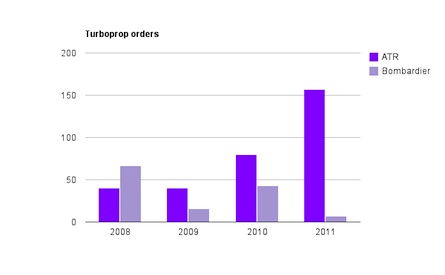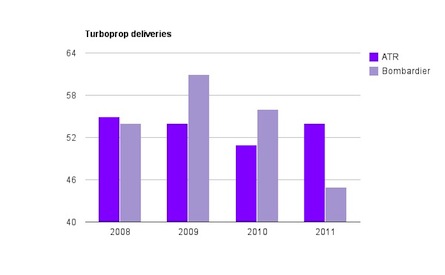Airline demand for regional turboprops continued a lop-sided rebound last year, with customers favouring ATR's 50-70-seaters nearly exclusively over Bombardier's QSeries.
The EADS-Alenia joint venture's combined order backlog for ATR42s and ATR72s swelled last year by 157 aircraft, nearly doubling the company's sales of 80 in 2010 and almost quadrupling sales of 40 only two years ago.
Bombardier had no answer as sales of the Q400 dropped last year to a historic low of only seven aircraft.
The disparity between the results made it difficult to reconcile the explanation from Bombardier Aerospace president Guy Hachey, who blamed the company's anemic sales record on "recurring fluctuations in the world economies".
 |
|---|
"ATR is better for the short haul mission," Seymour said. "That's why it is doing so well. ATR has a good customer base and many are stepping up to the new [ATR72]-600s. Bombardier needs to have a good year [for turboprop orders] to keep that line going."
Last year's performance does not appear to be a fluke. Since 2008, ATR has out-gained Bombardier's backlog. ATR's backlog has increased by 103 aircraft over that period, while Bombardier's backlog has dwindled by 83 Q400s.
 |
|---|
Still, it is clear both manufacturers have been moving in different directions. The results even reflect the different forecasts provided by the airframers. Bombardier and Embraer agree that 20-year demand for regional turboprops is no larger than 2,500 aircraft. ATR's forecast is more optimistic, predicting sales will be roughly 20% higher at 2,950 aircraft.
For now, ATR also remains more bullish on the near-term prospects for a 90-seat turboprop. The manufacturer is preparing to make a launch decision later this year, with Pratt & Whitney and General Electric developing new powerplants. Bombardier has been more reluctant to commit to a clean-sheet development programme.
The turboprop market continues to evolve. Embraer once competed at the lower-end of the market, and has made no attempt to revive its portfolio. However, China's Xian has unveiled plans to build upon its record with the 60-seat MA-600, which is developed from the Antonov An-26. The Chinese airframer also has launched the 70-seat MA-700 programme, with first flight expected in 2016.
Bagnato acknowledged the new threat from the East. "The Chinese will arrive," he said. "Maybe there is a question mark at the moment, but they will come."
Source: Air Transport Intelligence news























